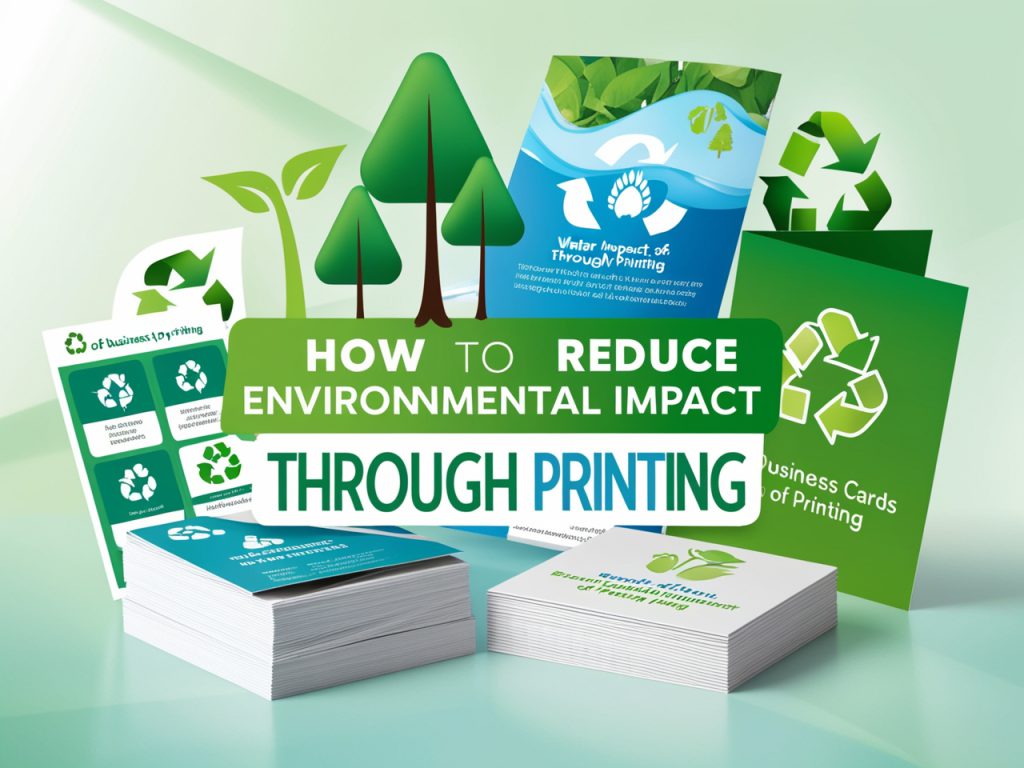
As businesses and individuals become more environmentally conscious, reducing the environmental impact of printing has become a priority. Whether you’re printing marketing materials, packaging, or internal documents, implementing eco-friendly practices can significantly minimize waste, conserve resources, and reduce pollution. By choosing sustainable materials, optimizing design, and adopting greener printing techniques, you can lower your environmental footprint and contribute to a more sustainable future. Here’s how you can reduce the environmental impact of your printing practices.
1. Choose Eco-Friendly Materials #
Selecting the right materials for your print projects can make a big difference in reducing environmental harm. Here are some sustainable options:
1.1 Use Recycled Paper #
- Why It Matters: Recycled paper is made from post-consumer waste, reducing the demand for virgin paper and conserving forests. By choosing paper with a high percentage of recycled content (e.g., 100% or 50% recycled), you can significantly reduce your carbon footprint.
- Best For: Business cards, brochures, flyers, packaging, and internal documents.
- Tip: Look for paper that is FSC-certified or Green Seal certified to ensure it meets sustainable forestry standards.
1.2 Opt for FSC-Certified Paper #
- Why It Matters: FSC (Forest Stewardship Council) certification ensures that the paper is sourced from responsibly managed forests that prioritize environmental conservation and fair labor practices.
- Best For: Premium marketing materials, packaging, and stationery.
- Tip: FSC-certified paper is available in various finishes (e.g., matte, gloss) to suit different project needs.
1.3 Use Sustainable Inks #
- Why It Matters: Traditional petroleum-based inks release volatile organic compounds (VOCs) into the air, contributing to air pollution. Sustainable inks, such as soy-based or vegetable-based inks, emit fewer VOCs and are derived from renewable resources.
- Best For: Business cards, brochures, packaging, and any print projects that require vibrant colors.
- Tip: Choose water-based or UV-cured inks for projects that need non-toxic, durable, and eco-friendly options.
2. Optimize Your Print Design #
The way your materials are designed can also affect their environmental impact. Here are some tips for designing with sustainability in mind:
2.1 Use Minimal Ink #
- Why It Matters: Excessive ink usage increases resource consumption and contributes to pollution. By using designs with less ink, you not only save resources but also improve recyclability.
- Best For: Brochures, flyers, and posters.
- Tip: Avoid large areas of solid color and full-bleed designs, which use more ink. Instead, opt for white space and simple, clean designs that still communicate your message effectively.
2.2 Choose Eco-Friendly Fonts #
- Why It Matters: Some fonts are designed to use less ink. Eco-friendly fonts have thinner lines or are optimized for minimal ink consumption without compromising readability.
- Best For: Business cards, brochures, flyers, and printed reports.
- Tip: Examples of eco-friendly fonts include Ryman Eco and Ecofont, which are specifically designed to save ink.
2.3 Maximize Paper Use #
- Why It Matters: Efficient use of paper reduces waste and minimizes the number of resources needed for printing.
- Best For: Multi-page documents, brochures, and catalogs.
- Tip: Design layouts that fit multiple pages or designs on a single sheet (known as ganging) to reduce paper waste. Additionally, print double-sided whenever possible.
2.4 Standard Paper Sizes #
- Why It Matters: Using non-standard paper sizes often results in excess waste, as leftover paper may not be reusable.
- Best For: Brochures, posters, and business documents.
- Tip: Stick to standard sizes like A4 or A5 for most print projects to minimize paper waste.
3. Adopt Greener Printing Technologies #
By upgrading to greener printing technologies, you can make a substantial impact on reducing energy consumption, waste, and pollution. Here’s how:
3.1 Switch to Digital Printing #
- Why It Matters: Digital printing produces less waste compared to traditional offset printing because it eliminates the need for printing plates. It also allows for on-demand printing, meaning you only print what you need, reducing overproduction and resource use.
- Best For: Short print runs, business cards, flyers, brochures, and personalized print projects.
- Tip: Use digital printing for small or customized projects to minimize waste.
3.2 Use Waterless Printing #
- Why It Matters: Waterless printing eliminates the need for water in the printing process, reducing water consumption and eliminating the risk of harmful chemical runoff into the environment.
- Best For: High-volume print projects like catalogs, magazines, and packaging.
- Tip: Waterless printing is ideal for businesses looking to reduce both water usage and chemical pollution.
3.3 Invest in Energy-Efficient Printers #
- Why It Matters: Energy-efficient printers consume less electricity, helping to lower your carbon footprint.
- Best For: Offices and businesses that print frequently.
- Tip: Look for printers with an Energy Star certification to ensure they meet energy-efficiency standards.
3.4 Optimize Print Runs with On-Demand Printing #
- Why It Matters: On-demand printing allows you to print only the exact number of materials you need, eliminating overprinting and reducing waste.
- Best For: Marketing materials, event flyers, brochures, and packaging.
- Tip: Use on-demand printing for projects with short lifespans, such as event promotions, to avoid printing excess materials that may go to waste.
4. Minimize Waste and Pollution #
Reducing waste and pollution from your print projects is essential for lowering your environmental impact. Here’s how you can implement waste-reduction strategies:
4.1 Use Biodegradable or Recyclable Materials #
- Why It Matters: Biodegradable materials break down naturally over time, while recyclable materials can be processed and reused, reducing landfill waste.
- Best For: Packaging, labels, business cards, and event materials.
- Tip: Choose biodegradable or recyclable packaging for product labels, event materials, and promotional items to ensure your materials don’t contribute to long-term environmental damage.
4.2 Implement a Recycling Program #
- Why It Matters: Establishing a recycling program for both printed materials and used printer cartridges reduces the waste that goes to landfills.
- Best For: Offices and businesses that regularly print documents, marketing materials, or packaging.
- Tip: Recycle paper and ink cartridges whenever possible and encourage employees or customers to recycle printed materials after use.
4.3 Reduce Packaging Waste #
- Why It Matters: Excessive packaging contributes to waste and resource depletion. Opting for minimal or sustainable packaging solutions helps cut down on waste.
- Best For: Product packaging, promotional items, and shipping materials.
- Tip: Choose minimalist packaging designs that reduce unnecessary materials, or use recyclable or biodegradable packaging materials.
4.4 Print Double-Sided #
- Why It Matters: Printing on both sides of the paper reduces the total amount of paper needed for a project, cutting down on waste and saving resources.
- Best For: Internal documents, brochures, booklets, and reports.
- Tip: Set your printer to default to duplex (double-sided) printing to save paper automatically.
5. Work with Sustainable Printing Partners #
Finding the right printing partner can further enhance your eco-friendly efforts:
5.1 Choose a Certified Eco-Friendly Printer #
- Why It Matters: Working with a printer that prioritizes sustainability ensures that your materials are produced in an environmentally responsible way. Look for certifications like FSC, Green Seal, or ISO 14001 to verify their eco-friendly practices.
- Best For: Large print runs, marketing materials, or corporate documents.
- Tip: Ask your printing partner about their environmental policies and whether they use sustainable materials and technologies.
5.2 Support Local Printers #
- Why It Matters: Choosing a local printer reduces the environmental impact associated with shipping and transportation, as materials don’t need to travel as far.
- Best For: Business cards, brochures, packaging, and event materials that need to be distributed locally.
- Tip: Select local printers to minimize transportation emissions and support your local economy.
6. Educate Your Audience #
Incorporating eco-friendly printing practices can also help you connect with customers and stakeholders who value sustainability:
6.1 Use Eco-Labels on Your Prints #
- Why It Matters: Adding eco-friendly labels or logos to your printed materials informs customers that you’re committed to sustainable practices, enhancing your brand’s reputation.
- Best For: Business cards, packaging, brochures, and product labels.
- Tip: Use symbols like the FSC logo or a “Printed on Recycled Paper” note to highlight your eco-friendly efforts.
6.2 Promote Digital Alternatives #
- Why It Matters: Encouraging customers to opt for digital versions of catalogs, brochures, or reports can further reduce the environmental impact of printing.
- Best For: Newsletters, reports, and marketing materials.
- Tip: Offer digital alternatives for certain materials (e.g., sending digital brochures or e-receipts) to reduce paper use and printing costs.
Conclusion #
By adopting eco-friendly materials, optimizing design, and implementing greener printing technologies, businesses and individuals can significantly reduce the environmental impact of their print projects. Sustainable printing not only conserves resources and reduces waste but also supports your brand’s commitment to environmental responsibility. Whether you’re choosing recycled paper, using vegetable-based inks, or implementing on-demand printing, every step toward sustainability counts.
You can find free business card templates on Freepik.
Learn more about the different printing methods in this comprehensive guide.





